So, you want to work in historic preservation?
You’re going to need a deep knowledge and appreciation for history, architecture, and cultural heritage—not to mention practical skills in research, conservation, and even legislative advocacy. It's a field that blends artistry with meticulous attention to detail, aiming to safeguard our tangible past for future generations.
If you're considering this path, here are several crucial aspects to consider:
“The more people appreciate their environments, the more they are attentive to the quality of life in their communities. Preservation is about giving life to the past and making it meaningful for the present and the future.”
“Preservation is a huge umbrella term—it can be about ideology and memory, it can be an intellectual engagement, and it can be a very real physical intervention and interpretation. ”
Want to learn more? Connect with our staff!
Passion for History and Heritage: At the core of historic preservation is a passion for history and a commitment to conserving the physical remnants of our past. Whether it's restoring a historic building, documenting cultural landscapes, or preserving archaeological sites, professionals in this field are driven by a desire to understand and protect what came before us.
Interdisciplinary Knowledge: Historic preservation is interdisciplinary by nature, drawing on fields such as architecture, archaeology, urban planning, law, and environmental science. A solid foundation in these areas provides the breadth of knowledge necessary to navigate the complexities of preservation projects.
Research Skills: Preservationists must be adept researchers, capable of delving into archives, conducting historical surveys, and analyzing architectural features. Understanding the historical context and significance of a structure or site is crucial for making informed decisions about its preservation.
Technical Expertise: Practical skills in conservation techniques, such as masonry, carpentry, and materials science, are essential. Preservationists often collaborate closely with craftsmen and contractors to ensure that restoration work maintains historical authenticity while meeting modern standards of safety and sustainability.
Legal and Regulatory Understanding: Familiarity with preservation laws and regulations is vital. Preservationists often work within a framework of local, state, and federal guidelines that govern what can and cannot be done to historic properties. Navigating these regulations requires attention to detail and a nuanced understanding of preservation ethics.
Community Engagement: Preservation projects frequently involve engaging with communities, stakeholders, and advocacy groups. Effective communication and collaboration skills are essential for building consensus and fostering support for preservation efforts.
Ethical Considerations: Preservationists must navigate ethical dilemmas, such as balancing historical authenticity with practical usability or addressing issues of cultural sensitivity and representation. Respect for diverse perspectives and a commitment to inclusivity are crucial in this regard.
Adaptability and Innovation: While rooted in tradition, historic preservation also benefits from innovation. Techniques evolve, new materials become available, and sustainable practices emerge. Professionals in this field must stay current with advancements while respecting the time-tested methods that define preservation work.
Career Paths and Opportunities: Historic preservation offers diverse career paths, including roles in government agencies, nonprofit organizations, architectural firms, museums, and academia. Specializations range from conservation science to heritage tourism, providing opportunities for both hands-on practitioners and policy-makers.
Challenges and Rewards: Preservation work can be challenging, often requiring patience, perseverance, and the ability to navigate setbacks. However, the rewards are significant—contributing to the preservation of our cultural heritage, revitalizing communities through heritage tourism, and leaving a lasting impact on future generations.
Continuous Learning: Lastly, a career in historic preservation is a journey of continuous learning and personal growth. New discoveries in archaeology, advances in conservation science, and evolving societal attitudes towards heritage all shape the field. Embracing lifelong learning ensures that preservationists remain adaptive and responsive to the dynamic challenges of their profession.



